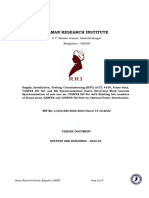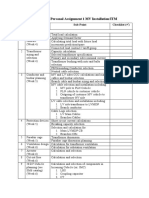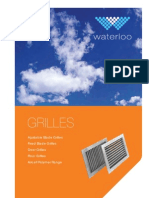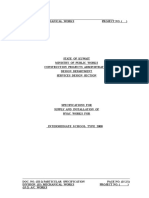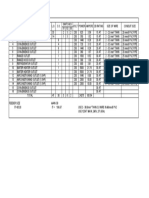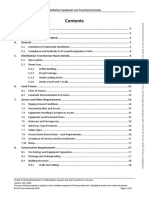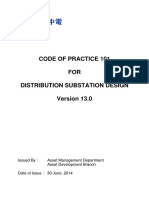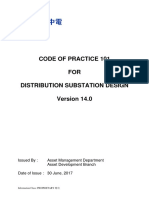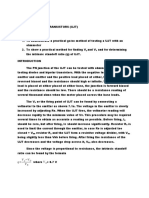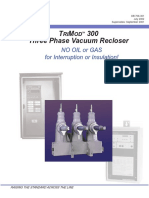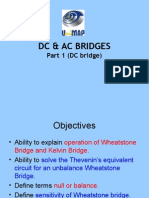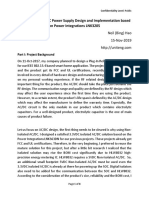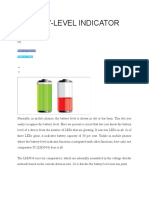Cop101 V7 1
Uploaded by
Kei WongCop101 V7 1
Uploaded by
Kei WongCODE OF PRACTICE 101 FOR DISTRIBUTION SUBSTATION DESIGN Version 7.
Issued By :
Asset Management Department Electrical Engineering Branch
Date of Issue : July, 2000
Code of Practice No. 101 for Distribution Substation Design
CODE OF PRACTICE 101 FOR DISTRIBUTION SUBSTATION DESIGN VERSION 7
INDEX
Page 1. 2. 3. 3.1 3.2 3.3 4. 4.1 4.2 4.3 4.4 4.5 4.6 4.7 4.8 4.9 4.10 4.11 4.12 4.13 5. 5.1 5.2 5.3 INTRODUCTION..........................................................................................................1 OBJECTIVES ................................................................................................................1 PROJECT MANAGEMENT.........................................................................................1 Acquisition of A Substation Site ...................................................................................1 Main Considerations ......................................................................................................1 Approval of Drawings....................................................................................................2 DESIGN CRITERIA......................................................................................................2 General ...........................................................................................................................2 Special Requirements for Basement and Upper Floor Substations ...............................4 Layout ............................................................................................................................6 Foundations....................................................................................................................8 Cable Trenches...............................................................................................................8 Doors..............................................................................................................................9 Ventilation....................................................................................................................11 Internal Electrical Installation ......................................................................................12 Substation Name ..........................................................................................................14 Accessories ..................................................................................................................14 Customers Switchroom...............................................................................................15 Fire Protection Requirement ........................................................................................15 Vermin Proofing of Equipment ...................................................................................15 OUTDOOR SUBSTATION ........................................................................................16 General .........................................................................................................................16 Type of Fencing ...........................................................................................................17 Other Requirements .....................................................................................................17
Version No. 7 May 2000
Index - 1
Code of Practice No. 101 for Distribution Substation Design
INDEX (cont'd)
Page 6. PROVISION, INSTALLATION AND MAINTENANCE OF CUSTOMER SUBSTATION BUILDINGS AND ACCESSORIES .................................................18 DRAWINGS ................................................................................................................21
7.
APPENDICES A, B, C, D
Version No. 7 May 2000
Index - 2
Code of Practice No. 101 for Distribution Substation Design
Page 1
1.
INTRODUCTION This Code of Practice details the general principles to be applied to the design of distribution substations, including substations located at ground floor, basement, upper floor level and outdoor areas. For substations situated in a special environment, special designs approved by CLP Power may be adopted.
2.
OBJECTIVES The objectives of this Code of Practice are to ensure that all distribution substations provided by the customers or developers are designed to the same standard, and fully comply with the requirements of Fire Services Department (FSD), Buildings Department, Hong Kong SAR Government and those of CLP Power. The requirements in this Code of Practice may be changed as new equipment becomes available, new techniques are developed or because of new requirements from FSD or CLP Power.
3.
PROJECT MANAGEMENT 3.1 Acquisition of A Substation Site Bearing in mind the difficulties likely to be encountered in acquiring a substation site once a development has been completed, careful consideration must be given at the initial design stage whether or not to request for a substation site.
3.2
Main Considerations Considerations should be given to the following points when designing the substation:3.2.1 Distribution substations shall be planned having in mind the future loading and development of the area. Many of the requirements are associated with the safety of the operational personnel, the public and the equipment. Priority should be given to safety. Prepare a supply proposal so that the number and type of plant to be accommodated can be estimated. Obtain adequate drawings and information from the customer, developer or architect for design purpose, e.g. site plan, ground floor, upper floors and basement plan, structural plans, etc.
3.2.2
3.2.3
3.2.4
Version No. 7 May 2000
Code of Practice No. 101 for Distribution Substation Design
Page 2
3.3
Approval of Drawings 3.3.1 Substation layout plans prepared by architects or consultants should be approved by the Planning and Design Manager of the relevant Region of CLP Power. Standard (or typical) substation layout plans submitted by the Hong Kong Housing Authority should be approved by the Electrical Engineering Manager of the Asset Management Department, CLP Power.
3.3.2
4.
DESIGN CRITERIA Substations should be designed to comply with the criteria in this section. Substations sited other than at ground floor locations should be equipped with non-flammable transformers such as SF6 transformers. Substations located at ground floor are equipped with silicone oil filled transformers or equivalent to avoid the need for a fixed fire fighting installation. 4.1 General 4.1.1 Substations shall be situated at the periphery of the building and be directly accessible from open air (non-covered area) at all times. The permanent access to the substation shall be of adequate height, width and of sufficient strength to withstand the combined weight of the transformer and the conveying vehicle. All substations shall comply with the Hong Kong Electricity Ordinance 1990 (Cap. 406), the Hong Kong Building Ordinance (Cap. 123) and the Fire Services Requirements for Consumer Substations using Oil Filled Transformers and Switchgear in Buildings (latest version of NP/101), Part X of FSD Circular Letters and the related Codes of Practice on Fire Services. The substation minimum clear headroom should be 3.3m. If a ventilation air trunking has to be located above the plant access door, the headroom in this area should be 3.7m. When single core cables are used for the connection between the 11kV/LV transformer LV terminals and the customers switchgear, the customers switchroom should be immediately adjacent to, above or below the substation. Cable sealing to 2-hour fire resistance period (FRP) by Multi Cable Transit (MCT) system shall be used.
4.1.2
4.1.3
4.1.4
Version No. 7 May 2000
Code of Practice No. 101 for Distribution Substation Design
Page 3
4.1.5
The substation ceiling and customers switchroom ceiling shall be of suitable waterproof construction to prevent water leakage. No water pipes, drainage pipes or customers installation shall be located in or pass through any part of the substation.
4.1.6 4.1.7
No civil expansion joint shall be located in any part of the substation. Adequate and permanent ventilation to open air which is completely segregated from the main building shall be provided. Illumination inside the substations should generally be 200 to 300 lux. Ground level substations should normally be 150mm higher than the outside (pavement) level in order to minimise the risk of flooding. The openings for cable inlet shall be properly sealed by the developer/customer so as to prevent water ingress into the substation and be of two hour FRP construction. Not more than 3 transformers shall be accommodated within any one room or enclosure. Typical distribution substation layouts in this Code of Practice should be used wherever possible. Substation walls are to be tiled up to a height of 1500mm above floor level with 150mm x 150mm white ceramic tiles. Above the tiles, the wall and the ceiling should be cement and sand plastered and finished with one coat of liquid prepolymer sealing and two finishing coats of white acrylic resin based coating in glossy finish. The substation floor should be cement and sand rendered with trowelled smooth finish and painted with one coat of polyurethane sealer and two coats of grey epoxy dustproof coating.
4.1.8
4.1.9
4.1.10
4.1.11
4.1.12
4.1.13
4.1.14
Adjacent and adjoining occupancies and hazards must be taken into account, particularly in respect of avoiding, as far as possible, wet environments above the substation - water tanks, toilets and the like. If these cannot be avoided, double ceiling slab should be provided above the substation.
Version No. 7 May 2000
Code of Practice No. 101 for Distribution Substation Design
Page 4
4.1.15
No storage of transformer or switchgear insulant is allowed in the transformer room or customer switchroom. Where SF6 is used as the insulant, a gas leakage alarm bell and alarm light should be provided on the external wall adjacent to each access point and inside the substation as shown on the substation layout drawing. All external steelwork shall be stainless steel of the low carbon type AISI 316L. This specification applies to all doors, door frames, louvres, rat guards, etc. Internal steelwork (air trunking, hangers, chequer plate, etc.) should be hot dip galvanised and finished with one coat of calcium plumbate primer and two finishing coats of grey synthetic paint.
4.1.16
4.1.17
4.2
Special Requirements for Basement and Upper Floor Substations 4.2.1 Basement Substations 4.2.1.1 Basement substations shall be directly accessible from the open air at ground floor by a separate and independent staircase with ventilation. A vehicular access leading from street level to the substation should be provided for plant delivery. A smoke lobby with self-closing doors fitted with panic bolt leading to the adjacent public area of the building shall be provided. 4.2.1.2 Basement substations should not be located at the lowest basement level in order to minimise the risk of flooding. There should be at least one basement level below the substation. The floor area of each level of basement should be basically the same. 4.2.1.3 A ground floor 11kV switch room is required for basement substations located at 7m or more below ground level. 4.2.1.4 A fan room should be provided at ground level for accommodating the ventilation fans for the substation. 4.2.1.5 Flooding alarm light should be provided at each access point of the basement substation. A normally open alarm clean contact is required for monitoring by Distribution Automation.
Version No. 7 May 2000
Code of Practice No. 101 for Distribution Substation Design
Page 5
4.2.1.6 A suitable damp-proof course shall be provided on the outside of all external walls which are below ground level and which separate the substation from unexcavated ground. 4.2.1.7 Each basement substation must be equipped with emergency lighting units, the batteries of which are charged from the substation local supply. The emergency lighting units shall enable a safe exit to be made from the substation in the event of loss of lighting supply 4.2.1.8 A sump pit with minimum pumping capacity of 3 litres per second and sufficient head and removable covers is provided. A high level detector is fitted in the sump pit to raise an alarm inside the substation and activate the 11kV monitoring alarm system. A drainage pipe with valve is provided to drain water in the sump pit to the building drainage system. A change-over switch should be provided for the sump pump so as to operate from the customers supply when necessary. 4.2.2 Upper Floor Substations 4.2.2.1 Upper floor substations should be located at the periphery of the building. Plant access can be from a public area inside the building through a slab opening or by a vehicular access. A smoke lobby with self-closing doors fitted with panic bolt leading to the adjacent public area of the building shall be provided. Substations located below the fifth floor should be directly accessible by a separate and independent staircase. 4.2.2.2 In the case of plant access through a floor opening, the opening shall be provided with removable R.C. covers of two hour FRP construction. An I-beam together with an electrical hoist for lifting a minimum load of 6500kg shall be provided and maintained by the developer. An emergency lowering device with handwheel shall also be provided. The clear height of the hoisting equipment to the floor shall be minimum 3000mm under the hook. A change-over switch should be provided for the electrical hoist to operate from either the customers essential supply or the substation local supply.
Version No. 7 May 2000
Code of Practice No. 101 for Distribution Substation Design
Page 6
4.2.2.3 For substations located at high floor levels not accessible by a mobile crane at ground level, it is important to check the weight of the transformer. Lifts in the building which can be used for lifting the transformers should have minimum door opening 500mm in excess of the width of the transformer. 4.2.2.4 A ground floor 11kV switch room is required for substations located at 7m or more above ground level. 4.2.2.5 An independent cable chase/chamber shall be provided solely for CLP Power cables, be constructed to 2-hour FRP and have access from a public area within the building. Access doors and horizontal barriers with 2-hour FRP or steel platforms should be provided inside the cable chase at about 8 to 10m intervals. The centre lines of 11kV cables should generally be 150mm apart. Cat ladders are also required. 4.2.2.6 Each upper floor substation should be equipped with emergency lighting units, the batteries of which are charged from the substation local supply. The emergency lighting units shall enable a safe exit to be made from the substation in the event of loss of lighting supply.
4.3
Layout 4.3.1 General To avoid civil work in substations which are in service, the layout should be so designed to be adequate for the lifetime of the substation. The clearances and operating areas to be provided around the electrical plant should generally be as follows :11kV switchgear 1000mm in front of the panels. 1500mm in front of draw-out type 11kV circuit breakers. Where metering CB panels are installed, 2000mm for the operation of the VT lifting trolley may be required. 750mm on the other three sides of the switchboard.
Version No. 7 May 2000
Code of Practice No. 101 for Distribution Substation Design
Page 7
Transformer
900mm around the LV terminals. 750mm on the other sides (500mm minimum if space is limited). 1000mm in front of the board. 750mm on the two sides. The LV board will be anchored to the floor against a wall. The cable trench edge shall be 120mm from the wall. 750mm on two or three sides except the rear side which is against a wall.
LV board
LV capacitor bank
4.3.2
Electrical Plant 11kV switchgear (GIS or vacuum switchgear with air insulation) Transformer This normally consists of the total number of panels required for the particular project plus, if possible, one spare panel for future use. One, two or three transformers as planned. Normally one per substation. One per transformer. One per substation switchgear. with 11kV
LV board LV capacitor bank 30V battery and charger
Pilot marshalling boxes
Two located near to the 11kV switchgear. One per substation. One per substation with 11kV side metering equipment.
Remote terminal unit Summation installed) panel
(if -
The battery/charger unit and pilot marshalling boxes should be wallmounted near the 11kV switchgear. The LV board should not face the transformer LV terminals for safety reasons. 4.3.3 Plant Dimensions, Weights and Design Appendix A shows the typical plant dimensions, weights and outlines for various types and rating of equipment.
Version No. 7 May 2000
Code of Practice No. 101 for Distribution Substation Design
Page 8
4.4
Foundations 4.4.1 The transformer foundation shall be capable of supporting a minimum load of 6500kg. This caters for future uprating to above 2000kVA. The minimum dimensions of the transformer plinth should be 1.8m long x 1.2m wide and level with finished floor level. The 11kV switchgear foundation shall be capable of supporting a maximum static plus dynamic load of 17kN per panel. The minimum cover between the finished floor level and the reinforcement bar of the foundation should be 80mm. The floor surface shall be flat and within a tolerance of 1mm in 1000mm.
4.4.2
4.4.3
4.5
Cable Trenches The cross-sectional areas of the cable trenches should not be reduced by the ground beams or other civil structures. At the junction of cable trenches for power cables of different voltages, segregation by reinforced concrete should be provided. The invert level of the cable trenches at the boundary of a substation should be 850mm (if trench depth is 1000mm) below the pavement level. If ground beams are present at the boundary of a substation, the remaining clearance under the beams shall be 500mm minimum. The cable trench steel chequer plates should be marked with numbers (left to right or clockwise convention) to avoid being misplaced. Proper supports such as a removable angle iron should be provided at the bends and tee-points. 4.5.1 HV Cable Trenches HV cable trenches shall be minimum 1000mm deep and 1200mm deep under the switchgear, and 4.5.1.1 4.5.1.2 800mm wide for 11kV switchgear panels; 400mm wide for 11kV cables from 11kV switchgear to transformers; the final section under the transformer HV terminal can be 300mm wide.
4.5.2
LV Cable Trenches 4.5.2.1 LV cable trenches should generally be 800mm wide x 1000mm deep.
Version No. 7 May 2000
Code of Practice No. 101 for Distribution Substation Design
Page 9
4.5.2.2
Trench for LV single core cables from the transformers to customers main switchroom should be 800mm wide x 1000mm deep for 3 MCT in triangular form, 1000mm wide x 600mm deep for 3 MCT in line horizontally and 800mm wide x 600mm deep for 2 MCT in line horizontally.
4.5.3
Pilot Cable Trench A short trench 300mm wide x 1000mm deep should be extended to where the 11kV pilot cable marshalling boxes are installed.
4.5.4
Trench Construction All trenches shall be covered with 6mm thick steel chequer plates. In the case of a suspended trench, the trench walls shall be constructed to have a 2 hour FRP. All junctions of trenches shall be chamfered to 150mm x 150mm. Both sides of the cable trench under the 11kV switchgear should be of dense concrete construction to a minimum width of 200mm for supporting the switchgear.
4.5.5
Trench Outlet 4.5.5.1 All trench outlets should have the same width as the trench and 150mm diameter G.I. sleeves should be provided. For basement and upper floor substations, adequate number of MCT holes should be provided for incoming 11kV XLPE cables and pilot cables, taking into account the number of panels in the substation.
4.5.5.2
4.6
Doors All substation doors shall open outwards into an unobstructed space with a 180 swing and shall be of stainless steel. A DANGER notice together with the Substation Nameplate, to be supplied by CLP Power, indicating the full company registered name, the CLP Power logo, substation identification number, substation name and CLP Power emergency telephone number are to be fixed to the substation door. 25mm diameter galvanised steel eye bolts should be installed on internal wall on both sides of all doors at 1m above the floor for hanging a temporary caution notice. A 3m long stainless steel chain and a chain box should also be provided.
Version No. 7 May 2000
Code of Practice No. 101 for Distribution Substation Design
Page 10
4.6.1
Type of Door 4.6.1.1 Double leaf door shall be 2400mm wide and normally 2800mm high for transformer access. A 700mm wide x 2100mm high wicket door with handles shall be provided in one leaf for personnel access. Drawings No. COP101/752 and 753 show the details of this type of door. 4.6.1.2 Double leaf door 1500mm wide x 2500mm high shall be provided for 11kV switchgear and personnel access. Drawing No. COP101/756 shows this type of door. Single door 930mm wide x 2100mm high with handles shall be provided for personnel access. Drawing No. COP101/750 shows this type of door.
4.6.1.3
Doors with 2 hours FRP shall comply with the relevant requirements of the Buildings and Fire Services Regulation and shall have relevant approval certificates/documents accepted by FSD (drawings in this Code of Practice are only indicative in terms of door dimensions, wickets, etc.). 4.6.2 Lock A substation has only one designated personnel access door and this door is fitted with an emergency exit deadlock set with panic bar and flush key hole. A second, or emergency exit door should be provided for substations longer than 10m (possibly a wicket door in a double leaf door). Such an emergency exit will be provided with a panic bar which will operate top and bottom bolts of the door, but which will not have an external key. In the case of a double leaf switchgear access door an emergency exit deadlock set with panic bar will operate one leaf of the door if this is the only access. Main double leaf transformer access doors will lock by top and bottom bolts from the inside.
Version No. 7 May 2000
Code of Practice No. 101 for Distribution Substation Design
Page 11
4.7
Ventilation 4.7.1 Indoor substations housing transformers shall be sufficiently well ventilated with a fixed ventilation system to cope with the total heat dissipated at full load, with a margin to provide for cyclic overloads. The height of the ventilation outlet to free air should be 2.4m above footpath or street level. Effective inlet louvre area shall be a minimum of 1.12 sq.m for every 3000kVA of installed transformer capacity. For each 1500kVA transformer at or above ground level with heat dissipation of about 11kW, a 630mm diameter fan and 0.65 sq.m air trunking (maximum 9m long) are required. If the transformer is in a basement, 800mm fan and 0.85 sq.m trunking should be provided. If a 2000kVA transformer is installed at ground level, 800mm diameter fan and 0.85 sq.m air trunking will be required. If the 2000kVA transformer is in a basement substation, two 630mm fans should be considered. The standard exhaust fans provided by CLP Power will be the WOODS 800mm, or 630mm, 700 RPM type or one of equivalent performance as follows:Diameter (mm) 800 630 Air Extraction Rate (Cu. m/hr.) 7,000 3,500 Static Pressure (N/m2) 100 70 Maximum Noise Level 63 dB(A) 56 dB(A)
4.7.2
4.7.3
4.7.4
4.7.5
4.7.6
RPM 700 700
Where a long air duct (approximately 30m to 50m) is required, axial flow type fan with ventilation rate of 7000 cu.m/hour may be required in the middle of the air duct to provide the necessary ventilation. Detailed design depends on the number of bends and site conditions. 4.7.7 The exhaust fan should be controlled by a temperature sensing device to avoid unnecessary operation.
Version No. 7 May 2000
Code of Practice No. 101 for Distribution Substation Design
Page 12
4.7.8
The ventilation trunking shall be constructed with the minimum number of bends and in such a way as to efficiently remove hot air from each transformer. The inlet louvres and extraction trunking shall be so designed as to ensure the passage of air across the transformer, and eliminate any possible short circuit of the air flow. The inlet and exhaust fans, if installed, shall be switched on simultaneously. The air trunkings should not pass through public areas. If this cannot be avoided, the trunkings shall be equipped with facility for maintenance and be of 2 hour F.R.P.
4.7.9
Where possible the air intake associated with the transformer should be positioned such that the wire mesh at the intake mouth can be cleaned with the transformer energised, without endangering the person carrying out the work. Indoor substations housing 11kV switchgear normally have ventilation louvres only but a ventilation system should be provided for a large 11kV switchroom. The noise level generated by the ventilation system shall comply with the requirement of the Noise Control Ordinance and in no case should it exceed the existing average ambient noise level by 5 dB(A). A hoisting hook/eye bolt to withstand 100kg shall be provided at the ceiling next to the removable panel of the air trunking, or above the fan, in order to facilitate fan replacement.
4.7.10
4.7.11
4.7.12
4.8
Internal Electrical Installation The distribution board, and the electrical wiring for substation lighting and power (power socket and ventilation fan) shall be provided and installed together with the substation in accordance with the substation layout drawing. The electrical wiring shall be run in surface mounted steel conduits. CLP Power will provide the supply source. 4.8.1 Distribution Board The distribution board should be located near the main access door and shall house a 30A double pole main switch together with an adequate number of final circuits protected by mcbs as follows :-
Version No. 7 May 2000
Code of Practice No. 101 for Distribution Substation Design
Page 13
4.8.1.1
At least two 5A final circuits for all lighting installations controlled by two single pole switches with pilot lamp located next to the main access door. Fluorescent batten fittings with 40W 1.2m twin lamps should be used and fixed on the wall at 2.1m above floor level or suspended from the ceiling at 2.8m above floor to provide adequate illumination in the working area. Some of the fluorescent lamps should incorporate an emergency lighting unit as shown on the layout drawings. A 15A final circuit for each exhaust fan shall be connected to a 13A fused spur unit adjacent to the exhaust fan. The exhaust fan shall be controlled by a double pole switch and a temperature sensing device. A 15A final circuit shall be provided for 11kV switchgear heaters. The rating of the heaters is typically 2 x 50W per switchgear panel. An earthing terminal shall be provided adjacent to the distribution board for connecting all exposed metallic parts via appropriate conductors. A 20A final circuit for 13A socket outlets protected by an RCCB with overload protection, shall be provided.
4.8.1.2
4.8.1.3
4.8.1.4
4.8.1.5
4.8.1.6
4.8.2
Essential Supply An independent single phase supply shall be provided for the 30V battery charger for 11kV switchgear. In addition, an independent single phase supply circuit from the transformer LV side shall be provided for the distribution automation equipment.
4.8.3
Supply Source Source of supply shall be from the local transformer LV terminal. Where a substation houses switchgear only, the supply should be from the nearby CLP Power LV network. If not available, the supply shall be from the customers LV main distribution board from which it is metered and the customer must be advised not to switch off this supply.
4.8.4
Installation Requirement All wiring installed by CLP Power will be of minimum 4mm 2 core PVC armoured.
Version No. 7 May 2000
Code of Practice No. 101 for Distribution Substation Design
Page 14
Each circuit from the local transformer terminal shall be protected by HRC fuse, normally 30A for the distribution board and 10A for the 30V battery charger. 4.8.5 Earth Bonding All metallic parts such as steel door frames, exhaust fan trunking, louvres, pipework for fixed fire fighting installation, etc., shall be connected to the earthing terminal at the distribution board by copper conductors not less than 6mm. One earthing terminal for emergency use should be provided at a suitable position above ground inside the substation. 4.8.6 In order to facilitate the installation of internal wiring and control wiring, a cable tray system should be provided. To allow a temporary supply cable to get in/out of the substation, a 150mm diameter through wall hole with both sides covered by removable steel plates should be provided.
4.8.7
4.9
Substation Name The following principles shall be followed when naming distribution substations :1. 2. 3. 4. Building name, or Street number, or Village name, or The generally accepted location name.
The substation name shall not be more than 25 characters.
4.10
Accessories The following drawings show the accessory details which are used in conjunction with distribution substations. 4.10.1 MCT steel former of 200mm diameter, Drawing No. COP101/736 refers. MCT steel former of 150mm diameter, Drawing No. COP101/737 refers. Steel wall bracket and wooden cleat for holding single core cables, Drawing No. COP101/792 refers.
4.10.2
4.10.3
Version No. 7 May 2000
Code of Practice No. 101 for Distribution Substation Design
Page 15
4.10.4
Steel wall bracket and wooden cleat for holding 11kV cables, LV cables Drawing No. COP101/793 refers. Rat guards, Drawing No. COP101/794 refers. Emergency exit deadlock set, Drawing No. COP101/758 refers. Typical arrangement of panic bolt without external lock facility, Drawing No. COP101/759 refers. DANGER notice and Substation Nameplate, Drawing No. COP101/795 refers.
4.10.5
4.10.6
4.10.7
4.10.8
4.11
Customers Switchroom Appendix B outlines the general requirements relating to the design of customers switchrooms.
4.12
Fire Protection Requirement Please refer to Appendix C Substation Fire Protection.
4.13
Vermin Proofing of Equipment Some 11kV distribution substations in Hong Kong are located in buildings with a dusty, damp and vermin infested environment. The vermin are usually small animals such as rats, lizards and birds, etc. and insects such as cockroaches and flies, etc. To avoid problems of hygiene, corrosion and risk of insulation breakdown inside the electrical equipment caused by the vermin, vermin proofing is normally achieved by a combination of means. The substation building itself will act as the first line of defence while the electrical equipment design will act as the second line of defence. In the case of indoor substations, the first line of defence is by means of , ! Substation walls ! Doors ! Rat guards at the ventilation louvres and grills ! Sealing of cable trenches which pass outside the substation.
Version No. 7 May 2000
Code of Practice No. 101 for Distribution Substation Design
Page 16
In the case of outdoor substations, vermin proofing mainly depends on the electrical plant itself. Electrical plant in substations is designed to different degrees of protection according to IEC 529. The 11kV switchgear is designed to IP4X while the LV boards are to IP2X. In general 11kV equipment is better protected than LV equipment. As it is not practicable nor economical to design all electrical plant in a substation to a vermin proofing level that will keep out all kinds of vermin, it is necessary to rely on effective maintenance of the substation which includes, ! regular cleaning and checking ! keeping the rat guards in good condition ! keeping all trench, door and wall seals in good condition ! keeping all equipment and cubicle door properly closed after use at all times ! reporting irregularities and restoring the vermin-proofing in good condition. For substations with a serious vermin problem, the following engineering solutions may be used ! Equipment with a higher degree of protection ! Fully enclosed substation with air-conditioning ! Pest control by specialist companies ! More frequent maintenance and cleaning of the substation.
5.
OUTDOOR SUBSTATION The general requirements for outdoor substations are given below. Depending on the substation site and the surrounding, special design features may have to be incorporated as appropriate. 5.1 General 5.1.1 All outdoor substations shall be fenced off and a gate with 180 swing shall be provided for plant/personnel access. The fencing and gate(s) shall be not less than 2.5m in height so as to prevent any unauthorised entry to the substation. No forced ventilation system is required. The layout design and foundations shall be basically the same as the indoor substations.
5.1.2 5.1.3
Version No. 7 May 2000
Code of Practice No. 101 for Distribution Substation Design
Page 17
5.2
Type of Fencing Galvanised wire mesh of gauge No. 10 and 50mm mesh shall be used and fixed on concrete post or 75mm x 75mm x 9mm steel angle posts connected to substation earth. An oil retaining sill of 150mm x 150mm shall be provided at the perimeter.
5.3
Other Requirements 5.3.1 The substation ground level shall be 150mm above the outside ground (pavement) level. Anti climbing guard shall be provided at the top of the fencing, for example, outriggers made up of 4 strands of barbed wire. DANGER notices shall be installed on the gate and the fencing. All trenches shall be sealed after cabling. The area inside the substation apart from trenches and plant foundations should be 200mm thick reinforced concrete slab. A 50mm diameter drainage pipe with valve shall be provided adjacent to the gate. The valve shall normally be closed for oil containment and shall only be opened in order to drain any accumulated rain water.
5.3.2
5.3.3 5.3.4 5.3.5
5.3.6
Version No. 7 May 2000
Code of Practice No. 101 for Distribution Substation Design
Page 18
6.
PROVISION, INSTALLATION AND MAINTENANCE OF CUSTOMER SUBSTATION BUILDINGS AND ACCESSORIES Provision, Installation and Maintenance of Customer Substation Buildings and Accessories are detailed as follows :C D indicates items provided/maintained by CLP Power indicates items provided/maintained by Developer/Customer
Item 1. Substation Civil Work 1.1 Substation accordance drawings building in with substation
Provision of Material
Installation
Maintenance
1.2 1.3
Kerb (after plant moved in) Re-painting of substation interior after commissioning Re-painting of external walls substation
D D
D N.A.
C D
1.4
N.A.
1.5
Wire mesh fencing for outdoor substation or package substation Sand and gravel for filling cable trench in outdoor substation
1.6
2.
Substation Fixed Installation 2.1 2.2 2.3 2.4 Hoist beam Hoisting machinery Louvre, including rat guard Exhaust fan D D D C D D D D D D D C
Version No. 7 May 2000
Code of Practice No. 101 for Distribution Substation Design
Page 19
6.
PROVISION, INSTALLATION AND MAINTENANCE OF CUSTOMER SUBSTATION BUILDINGS AND ACCESSORIES (contd) Provision of Material
Item 2. Substation Fixed Installation (contd) 2.5 2.6 2.7 2.8 Air trunking Cat ladder Drainage pipe with valve Sump pump substation) (for basement
Installation
Maintenance
D D D D
D D D D
D D D D
2.9
Notices for treatment of electric shock and for emergency action
3.
Substation Access 3.1 Substation door in accordance with typical drawings Emergency exit deadlock set with panic bar Lock for substation door Substation plates statutory notice D D D
3.2
3.3 3.4
C C
C C
C C
4.
Substation Electrical Fittings 4.1 Distribution board for substation supply in accordance with typical drawings Electrical fitting in substation including cable conduit, light fitting, emergency lighting unit, socket and internal wiring D D C
4.2
Version No. 7 May 2000
Code of Practice No. 101 for Distribution Substation Design
Page 20
6.
PROVISION, INSTALLATION AND MAINTENANCE OF CUSTOMER SUBSTATION BUILDINGS AND ACCESSORIES (contd) Provision of Material
Item 5. Substation Accommodation for Cables 5.1 5.2 Chequer plate Steel rack for holding cable cleats Cable brackets and cleats Cable tray in accordance with typical drawing * Sealing of cable entry opening Before cable entry After cable entry Tinned copper bar bonding terminal for earthing
Installation
Maintenance
D D
D D
D D
5.3 5.4
D D
D D
D D
5.5
D C D
D C D
D C D
5.6
6.
Substation Fire Protection Equipment 6.1 6.2 6.3 6.4 6.5 Portable fire extinguisher SF6 gas leakage alarm Fire detection system Fixed fire fighting installation Flooding alarm C D D D D C D D D D C D D D D
Version No. 7 May 2000
Code of Practice No. 101 for Distribution Substation Design
Page 21
6.
PROVISION, INSTALLATION AND MAINTENANCE OF CUSTOMER SUBSTATION BUILDINGS AND ACCESSORIES (contd) Provision of Material
Item 7. Substation Plant & Equipment for Provision of Supply 7.1 7.2 7.3 7.4 7.5 7.6 7.7 7.8 Transformer Switchgear Battery charger Pilot marshalling box Remote terminal unit Cables Multi-cable transit plug-in Metering equipment
Installation
Maintenance
C C C C C C C C
C C C C C C C C
C C C C C C C C
* Note : Actual installation location to be advised on site by CLP Power Site Engineer.
7.
DRAWINGS Drawings No. COP101/701 to 713 Drawings No. COP101/721 to 724 Drawings No. COP101/731 to 737 Drawings No. COP101/741 to 743 Drawings No. COP101/750 to 759 Drawings No. COP101/761 to 763 Drawings No. COP101/771 to 775 Drawings No. COP101/781 to 783 Drawings No. COP101/791 to 798 Typical substation layout drawings (basement, ground floor and upper floor) Requirements for customers switchroom near to CLP Power substation Multi-cable transit plug-in arrangements Cable trench arrangements Substation doors Fans, louvres and metal trunkings Substation internal wiring installation Metal gates and fence for outdoor substations Miscellaneous
Version No. 7 May 2000
Code of Practice No. 101 for Distribution Substation Design
Appendix B-1
Design of Customer Switchroom
The purpose of establishing a customer switchroom in a building is to receive supply from CLP Power service equipment and accommodate the main switch and distribution board for controlling and distributing electricity to all parts of the building. Therefore in designing a customer switchroom, the following requirements shall be noted.
1.
Position of Switchroom Where the supply is taken from a transformer located within the building, the switchroom should be located immediately adjacent to, above or below the transformer substation so that the length and bending of CLP Power cables connecting to the main switch are kept to minimum. Where the supply is taken from a low voltage network, the switchroom shall be as near to the building entrance as possible.
2.
Access The switchroom must be readily accessible from a communal area at all times without the need to pass through any individual customers premises. At least one exit of a switchroom should open outwards and this emergency exit should be identified clearly.
3.
Routing of Outgoing Circuits The outgoing circuits from the switchroom such as the rising mains and the landlords services shall not pass through any individual customers premises. Where this cannot be avoided, suitable concrete ducts must be provided so that the cables installed therein can be replaced without the need to enter any individual customers premises at any time.
4.
Dimensions The switchroom shall not only be big enough to accommodate all the associated switchgear, distribution board and CLP Power metering equipment but also have adequate working space to facilitate installation, operation and maintenance.
Version No. 7 May 2000
Code of Practice No. 101 for Distribution Substation Design
Appendix B-2
4.1
Supply from Local Transformers The internal headroom shall be not less than 2.5m. The minimum depth shall be 2.75m when the switchroom is above the substation or adjacent to the substation provided that the customers main ACB can be positioned in line with the MCT holes. When the switchroom is below the substation or adjacent to the substation but designed to take the supply from more than one transformer, the minimum depth shall be 3.15m. In addition, the switchroom shall be wide enough to provide an unimpeded access of 650mm minimum on one side of the switchboard for gaining access to the rear of the switchboard.
4.2
Supply from LV Network The minimum internal dimensions for accommodating electrical services only shall be as follows:Headroom Width Depth : : : 2.5m 1.2m 1.2m
The access door(s) shall be not less than 0.8m wide and 2.1m high and the incoming terminals of the customers switch shall be at least 0.6m above the finished floor level.
5.
Cable Trench The width and depth of the cable trench for accommodating CLP Power single-core cables shall normally correspond to that in transformer substations. Customers outgoing cables should not share a common cable trench with CLP Power cables. Where this cannot be achieved, customers cables must be mounted permanently on the wall of the cable trench without interfering with CLP Power cables.
6.
Other Services No water pipe or drainage system is permitted within a customer switchroom. Where the switchroom is designed to accommodate other communication equipment such as telephone, communal aerial broadcasting distribution system or security system, such equipment and the associated wiring must be segregated from all electrical services.
Version No. 7 May 2000
Code of Practice No. 101 for Distribution Substation Design
Appendix B-3
7.
Ventilation and Illumination The switchroom must be provided with adequate ventilation and lighting.
8.
Means to Prevent Ingress of Water To prevent ingress of water, the switchroom shall be suitably constructed and not be under an expansion joint. Where the internal floor level is less than 100mm above the external floor level, a kerb of not less than 100mm above the external floor level shall be provided.
9.
Approval Procedure On the transformer substation detailed layout drawing, CLP Power will mark up the suggested trench layout and possible location for customers main ACBs for the developers consideration. The developer or his agent must resubmit the detailed switchroom layout incorporating the finalised cable trench and exact position of each main ACB for CLP Power approval prior to installation.
Version No. 7 May 2000
Code of Practice No. 101 for Distribution Substation Design
Appendix C-1
Substation Fire Protection
1.
Introduction This appendix summarises the Fire Services requirements in relation to approved CLP Power plant located in distribution substations and is based on the latest approved documents from the Fire Services Department. It highlights the type of fire fighting equipment which should be provided corresponding to the type, capacity and quantity of plant to be installed within the substation.
2.
Fire Services Requirements All distribution substations shall be incorporated in building plans formally approved by the Hong Kong SAR Government, and shall comply fully with the standard requirements of the Fire Services Department. The followings are the requirements :2.1 Passive Fire Protection General Requirements These requirements apply to all distribution substations. 2.1.1 Compartmentalisation The substation shall be completely segregated from the remainder of the building. All walls, floors and ceilings shall be of a minimum of two hour fire resisting material. The substation shall be situated at the periphery of the building. 2.1.2 Access Ground Floor Substations shall be directly accessible from the open air and where possible be provided with an additional door fitted with panic bolt for emergency personnel egress. There shall be no access way from the substation to the interior of the building. Basement Substations shall be directly accessible from the open air at ground floor by a separate and independent staircase for personnel. Plant access will be from public areas inside the building through an opening or door of two hours fire resistance period (FRP) construction. A smoke lobby with self-closing door fitted with panic bolt leading to a public area of the building adjacent the substation, shall be provided.
Version No. 7 May 2000
Code of Practice No. 101 for Distribution Substation Design
Appendix C-2
Upper Floor Substations shall be accessible from a public area of the building and where possible have vehicular access. A smoke lobby with self-closing door fitted with panic bolt leading to a public area (separate from the public area of the main access) adjacent to the substation, shall be provided. 2.1.3 Openings There shall be no unsealed openings left in any wall, ceiling or floor other than those which lead outside the building, e.g. door, exhaust fan outlet, ventilation louvres. Any service opening (e.g. cable trench outlet, trench or opening connecting to customers main switch room) shall be sealed to two hours fire resistance; this should also prevent passage of transformer insulant out of the substation as well as ingress of water into the substation. 2.1.4 Door Sill All door openings shall be provided with imperforate fire resisting sill of sufficient height, generally 150mm, to contain the total capacity of transformer insulant within the substation. This sill will also prevent ingress of water into the substation. 2.1.5 Ventilation Adequate and permanent ventilation to open air must be provided and shall be independent of any other ventilation system of the building. In any areas protected by a FFFI, the discharge sequence should include the automatic shutdown of the ventilation system and the closure of all ventilation openings, (see para. 2.2.2).
2.2
Active Fire Protection Fire Fighting Equipment Requirements for fire fighting equipment correspond to the type, capacity and quantity of plant (i.e. circuit breakers, transformers) to be installed inside that particular substation. The following table shows the requirements.
Version No. 7 May 2000
Code of Practice No. 101 for Distribution Substation Design
Appendix C-3
Fire Fighting Equipment Requirements for Distribution Substations Plant Fire Installed Fighting Equipment Substation Location Ground Floor Basement Upper Floors
Abb : SF6 Tx Sil Tx VCB RMU PFE FFFI FSD = = = = = = =
1 or 2 x 1,500kVA SF6 Tx. or Sil Tx. or 1 x 2,000kVA Sil Tx. + VCBs
3 x 1,500kVA SF6 Tx. or Sil Tx. + VCBs
1 x 4.5kg CO2 PFE 1 x 4.5kg CO2 PFE 1 x 4.5kg CO2 PFE
Sulphur Hexafluoride Filled Transformer Silicone-fluid Filled Transformer Vacuum Circuit Breakers Ring Main Unit Portable Fire Extinguisher Automatic Fixed Fire Fighting Installation Hong Kong Fire Services Department
2 x 4.5kg CO2 PFE 2 x 4.5kg CO2 PFE 2 x 4.5kg CO2 PFE
Where FFFI is installed, the replacement of a transformer or transformers with SF6 or Silicone-fluid type will not eliminate the necessity for FFFI, unless all transformers are SF6 or Silicone-fluid. Where FFFI is installed, portable CO2 fire extinguisher(s) will also be installed. Additional CO2 fire extinguishers may be required subject to the actual layout of the substation.
Note :
1) 2)
2.2.1
Automatic Fixed Fire Fighting Installation (FFFI) The normally approved type of FFFI for distribution substation uses CO2 as the extinguishing media. It consists of a gas reservoir which is in the form of gas cylinders and connected by pipes and discharge nozzles. Design for all FFFI shall be submitted to the Fire Services Department for approval.
Version No. 7 May 2000
Code of Practice No. 101 for Distribution Substation Design
Appendix C-4
2.2.2
Requirements for FFFI 2.2.2.1 All gas cylinders shall be housed in a separate room having access independent of substation access. Minimum design concentration of CO2 for fire suppression required for the FFFI shall be not less than 50% maintained for a period of not less than 20 minutes. FFFI shall be provided with means of both automatic and manual operation coupled to an audible and visual alarm device installed both outside and inside the substation. Lock-off unit, manual release, visual and audible devices, if located externally, shall be of weather-proof type or housed in weather-proof box to I.P. rating not less than IP54. Key box for lock-off key and the key for the weather-proof box should be provided and installed at the main personnel access inside the substation. A name plate must be posted adjacent to the lock-off unit with wording in English and Chinese to show the names of the fire services contractor, owner or management staff with telephone number to be contacted in emergency. A plate must be mounted adjacent to the lock-off unit with wording in English and Chinese stating the operation instructions for the system. This notice might be combined with the plate as per Clause 2.2.2.6, above. Detection system installed for the FFFI shall comprise smoke (ionisation) and heat (rate of rise and fixed temperature) detectors arranged in a Dual Zone manner as follows :(a) Zone 1 detection circuit is of smoke detector type and Zone 2 is of heat detector or vice versa. Upon actuation of either Zone 1 or Zone 2 circuit, local alarms and warning signs are generated without gas discharge. Only the actuation of both the detection circuits will cause the discharge of the CO2 flooding system.
2.2.2.2
2.2.2.3
2.2.2.4
2.2.2.5
2.2.2.6
2.2.2.7
2.2.2.8
(b)
(c)
Version No. 7 May 2000
Code of Practice No. 101 for Distribution Substation Design
Appendix C-5
2.2.2.9
Detectors and discharge nozzles should not be located at positions where the ventilation ducts and other services would have an adverse effect on the proper functioning of the detectors and nozzles.
2.2.2.10 Detectors and discharge nozzles must not be mounted directly above transformer tanks or switch panels. 2.2.2.11 The ventilation system (exhaust fans or air conditioners) must be shut off automatically prior to discharge of the system. 2.2.2.12 Means to seal up exhaust fan wall openings and trunking and ventilation louvres shall be provided and arranged to close automatically prior to discharge of the system. 2.2.2.13 Penetrations and openings in the substation shall be properly sealed with FSD approved material offering a fire resistance not less than FRP (Fire Resistance Period) of the element being penetrated to achieve the integrity of the room. 2.2.2.14 A.C. supply from the Power Company is the primary power supply for the FFFI and shall auto-changeover to a 24V d.c. standby supply in case of the a.c. supply failure. The capacity of the 24V d.c. supply shall be adequate for operating the alarm sounders in all zones for at least one hour or capable of maintaining the FFFI in operation for at least 24 hours. 2.2.2.15 The gas cylinders storage room must be indicated both in English and Chinese as CO2 Cylinder Room for CLP Power Substation. 2.2.2.16 FSD approved CO2 sign must be provided on the door of the substation. 2.2.2.17 The CO2 total gas flooding system shall be designed and installed to NFPA 12 (latest edition).
Version No. 7 May 2000
Code of Practice No. 101 for Distribution Substation Design
Appendix C-6
2.2.3
Automatic Fire Alarm Installation (AFA) Transformer and switchgear rooms having electrical equipment of above 1 Kilovolt but without Fixed Fire Fighting Installation (FFFI) shall be provided with an automatic fire alarm installation (AFA) as required by the Fire Services Department (FSD). Design of the AFA must be approved by the FSD. 2.2.3.1 Point type automatic heat detectors of combined fixed temperature and rate of rise type to BS 5443 : Part 5 shall be used. An independent fire detection zone should be provided for each transformer room, and CLP Powers switchgear room. Each detection zone must be provided with a remote fire indicator installed outside every entrance of the designated transformer room and/or CLP Powers switchgear room. Detectors must not be mounted directly above transformer tank and/or CLP Powers switchgear. Automatic fire alarm system shall be designed and installed to the latest edition of the Loss Prevention Council (LPC)/FOC Rules for Automatic Fire Alarm Installations for the Protection of Property and shall be in accordance with BS 5839 : Part 1 Fire Detection and Alarm Systems for Buildings, Part 1 Code of Practice for System Design, Installation and Servicing. In order to alert people working inside the transformer room, attention shall be paid to the audibility of fire alarms as stated in the above standards. AFA will not be provided for the concrete stand-alone substations where the spread of fire is not likely to happen.
2.2.3.2
2.2.3.3
2.2.3.4
2.2.3.5
2.2.3.6
2.2.4
Equipment Provision and Maintenance 2.2.4.1 Portable Fire Extinguisher All portable fire extinguishers are to be provided and maintained by CLP Power, generally 4.5kg CO2.
Version No. 7 May 2000
Code of Practice No. 101 for Distribution Substation Design
Appendix C-7
2.2.4.2
Fixed Fire Fighting Installation/AFA All FFFIs and alarm systems are provided and maintained by the customer or the owner of the building and must be inspected and tested by a registered contractor annually. At the time or any other time when an inspection or maintenance is carried out, the customer/owner shall send a copy of the Certificate of Fire Service Installations (FS 251) to CLP Power.
3.
Fire Services Department Circular Letters 3.1 Fire Services Requirements for Consumer Substations Using Oil Filled Transformer and Switchgear in Buildings 3.1.1 The room shall be completely segregated from the remainder of the floor by 2-hour FRP and situated at ground floor level at the periphery of the building. Be accessible from the open air, be provided with an alternative means of entry/exit where possible. Be adequately and permanently ventilated to open air. Cable trenches and ducts to be properly sealed to prevent the passage of oil outside the room. Door openings to be provided with imperforate fire-resisting sills of sufficient height to contain all of the oil in the transformers or other gear, or to have a soak pit filled with gravel which must be capable of containing the total capacity of oil in the Transformer Room. Where a single transformer or transformers of total capacity not exceeding 1,500kVA and associated switchgear is housed in a single compartment, one portable 1.5kg B.C.F. fire extinguisher is to be provided. Transformer and/or switchgear rooms not equipped with FFFI shall be provided with an automatic fire alarm installation (AFA) as required by FSD. Where 3.1.6 above is exceeded, then a fixed B.C.F., B.T.M., or CO2 installation is to be provided. Alternatively non-flammable transformers may be installed thus avoiding the need for a fixed installation. (see para. 4)
3.1.2
3.1.3 3.1.4
3.1.5
3.1.6
3.1.7
3.1.8
Version No. 7 May 2000
Code of Practice No. 101 for Distribution Substation Design
Appendix C-8
3.1.9
Fixed installations must be provided with means for both automatic and manual operation coupled to an audible alarm device. Where permanent ventilation is provided, means for closing or shuttering vents will be required to be coupled with the operation of the fixed installation. Where mechanical ventilation is provided, the operation of the fixed installation must shut off the ventilation system. The position of operating controls must be approved by the Director of Fire Services. The doors of rooms housing a fixed installation shall be suitably indicated with the appropriate symbol as per F.S.D. Circular Letters. The installation of the transformer or other gear is a matter for the electrical engineers but it is assumed that recognised safety and relief devices will be incorporated in the installation.
3.1.10
3.1.11
3.1.12
3.1.13
N.B.
3.2
Fire Services Miscellaneous Requirements for Non-Flammable or Lessflammable Transformers There is no objection to the use of the following types of transformer in multistorey buildings, subject to observation of the conditions shown under each type listed. 3.2.1 SF6 (Sulphur Hexafluoride) Transformer 3.2.1.1 Above Ground Level (a) (b) (c) No restriction on height. F.R.P. to be in accordance with B.O.O. Regulations. Adjacent/adjoining occupancies hazards to be taken into account. and exposure
(d)
No storage of SF6 cylinders in the Transformer Room or Customers Switch Room. Gas leakage alarm to be provided (visual and audible) with Trip Circuit. Standard F.S.D. requirements for Transformer Room to be complied with as stipulated.
(e)
(f)
Version No. 7 May 2000
Code of Practice No. 101 for Distribution Substation Design
Appendix C-9
3.2.1.2
In Basement (a) (b) F.R.P. to be in accordance with B.O.O. Regulations. Separate and independent staircases and mechanical ventilation to open air and complete separation from the main building. Adjacent/adjoining occupancies hazards to be taken into account. and exposure
(c)
(d)
No storage of SF6 cylinders in the Transformer Room or Customers Switch Room. Gas leakage alarm to be provided (visual and audible) with Trip Circuit. Standard FSD requirements for Transformer Room to be complied with as stipulated.
(e)
(f)
3.2.2
Midel 7131 (Pentaerythritol Ester) Filled; Silicone Fluid-filled and Dry Type Less-flammable Transformer 3.2.2.1 Above Ground Level (a) Transformer Room shall be located at the periphery of the building. Windows must be provided in the external wall, such windows shall be capable of being opened when required to supplement ventilation. Mechanical ventilation in form of an individual airconditioning system shall be provided for the Transformer Room. A lobby shall be provided outside the Transformer Room. A 1.5kg B.C.F. fire extinguisher or its appropriate equivalent alternative type of fire extinguisher is to be provided. Standard FSD Requirements for Transformer Room shall be complied with as stipulated.
(b)
(c)
(d)
(e)
Version No. 7 May 2000
Code of Practice No. 101 for Distribution Substation Design
Appendix C-10
3.2.2.2
In Basement (a) An independent and separate staircase (leading to open air at ground level) solely for the Transformer Room is to be provided. Mechanical ventilation in form of an individual airconditioning system shall be provided for the Transformer Room. A lobby shall be provided outside the Transformer Room. A 1.5kg BCF fire extinguisher or its appropriate equivalent alternative type of fire extinguisher is to be provided. Standard FSD Requirements for Transformer Room shall be complied with as stipulated.
(b)
(c)
(d)
(e)
Version No. 7 May 2000
Code of Practice No. 101 for Distribution Substation Design
Appendix D-1
Stainless Steel for Substation External Steelwork
1.
Material used shall be grade 316L stainless steel. This is a nickel-chromium steel containing molybdenum and a small amount of carbon. This steel is well suited to external applications particularly near coastal areas, and has good corrosion resistance.
2.
The Japanese standard for this steel is SU 316L and the American equivalent is TP 316L.
3.
The following notes relate to all external steelwork and in particular the doors :3.1 The hinges of each door leaf must be designed and constructed to withstand the weight of the door plus 50kg and be not less than four in number per leaf. Welding treatment must be suitable for grade 316L stainless steel and must not create weak spots at the weld. After welding, the weld surface must be brushed clean to remove all welding flux and surface dirt. The surface shall then be solvent cleaned to remove all residual dirt and grease. After drying an undercoat of primer followed by two undercoats of silver coloured enamel paint shall be applied to the weld surface. The doors and other external steelwork shall be covered with plastic sheets at the time of installation and such plastic sheets shall not be removed until the building construction work is completed, in order to avoid staining and damage to the steelwork by site construction work.
3.2
3.3
Version No. 7 May 2000
You might also like
- COP 101 Version 9.1 Document (Text) Jan 2006No ratings yetCOP 101 Version 9.1 Document (Text) Jan 200641 pages
- Bat-Dwg-Dd-Me-01-Eg-1101.02 - R0 - Earthing and Grounding Installation LayoutNo ratings yetBat-Dwg-Dd-Me-01-Eg-1101.02 - R0 - Earthing and Grounding Installation Layout1 page
- 2018-July-11 - STP Ventialtion Layout For Bbcl-ModelNo ratings yet2018-July-11 - STP Ventialtion Layout For Bbcl-Model1 page
- General Conditions For Approval of Distribution Package Substation (Open To Space)No ratings yetGeneral Conditions For Approval of Distribution Package Substation (Open To Space)15 pages
- D-104189-TC-E08-001 - 2 - Single Line Diagram (11KV, 415V)No ratings yetD-104189-TC-E08-001 - 2 - Single Line Diagram (11KV, 415V)5 pages
- 15010-Ar-Apt2-4-030-00 - Transformer Room Details - 20180611 PDFNo ratings yet15010-Ar-Apt2-4-030-00 - Transformer Room Details - 20180611 PDF1 page
- Pump Performance Datasheet: Operating Conditions LiquidNo ratings yetPump Performance Datasheet: Operating Conditions Liquid2 pages
- PK3-Phase B: Project Engineer: Engg. Arshad Project No.: 59-2016/2017 Company Name: AVIC INTL & HOT Customer Name: DGCANo ratings yetPK3-Phase B: Project Engineer: Engg. Arshad Project No.: 59-2016/2017 Company Name: AVIC INTL & HOT Customer Name: DGCA5 pages
- Go Grundfos Hydro MPC-E Duplex Booster Detail and SchematicNo ratings yetGo Grundfos Hydro MPC-E Duplex Booster Detail and Schematic1 page
- Abb Power Products Division: Technical Specification - UnisecNo ratings yetAbb Power Products Division: Technical Specification - Unisec12 pages
- Ventilation Calculation Summary Res - BLDG Typ-3No ratings yetVentilation Calculation Summary Res - BLDG Typ-31 page
- PVC Pipe (SCH.40, SCH.80, and SCH.120) CondensedNo ratings yetPVC Pipe (SCH.40, SCH.80, and SCH.120) Condensed7 pages
- For Distribution Equipment and Transformer Rooms - 3No ratings yetFor Distribution Equipment and Transformer Rooms - 35 pages
- Heat Pump BOQ....... Final and No RegretNo ratings yetHeat Pump BOQ....... Final and No Regret6 pages
- Jumbo Water Curtain Nozzle: HD Fire Protect Pvt. Ltd. Technical DataNo ratings yetJumbo Water Curtain Nozzle: HD Fire Protect Pvt. Ltd. Technical Data2 pages
- Evaluation:: Generator Performance ReportNo ratings yetEvaluation:: Generator Performance Report1 page
- Ts108 Technical Standard For Distribution Equipment and Transformer RoomsNo ratings yetTs108 Technical Standard For Distribution Equipment and Transformer Rooms30 pages
- COP 101 Version 12 Document (Text) June 2012No ratings yetCOP 101 Version 12 Document (Text) June 201245 pages
- (EE) CLP-Cop101 Version 15 Black LettersNo ratings yet(EE) CLP-Cop101 Version 15 Black Letters51 pages
- CM-1300 - CM-1350: Instruction Manual Instruction Manual Manual de Instrucciones Manuel D'InstructionsNo ratings yetCM-1300 - CM-1350: Instruction Manual Instruction Manual Manual de Instrucciones Manuel D'Instructions52 pages
- JEE Mains 2025 28 Jan Shift 2 Question Paper With Solutions - Download PDFNo ratings yetJEE Mains 2025 28 Jan Shift 2 Question Paper With Solutions - Download PDF18 pages
- Simple Electric Motor & Generator ModuleNo ratings yetSimple Electric Motor & Generator Module8 pages
- Patrick, Dale R. - Fardo, Stephen W. - Rotating Electrical Machines and Power Systems-Fairmont Press, Inc. (1997)No ratings yetPatrick, Dale R. - Fardo, Stephen W. - Rotating Electrical Machines and Power Systems-Fairmont Press, Inc. (1997)591 pages
- Solar Refrigeration Using Peltier ModuleNo ratings yetSolar Refrigeration Using Peltier Module5 pages
- Physics & Maths Trade Syllabus For Railway Alp 2 Stage Exam (Part-2)No ratings yetPhysics & Maths Trade Syllabus For Railway Alp 2 Stage Exam (Part-2)4 pages
- MEMS Capacitive Microphones: Acoustical, Electrical, and Hidden Thermal-Related IssuesNo ratings yetMEMS Capacitive Microphones: Acoustical, Electrical, and Hidden Thermal-Related Issues9 pages











